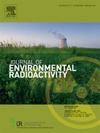Development and testing of a continuous maritime monitor for radionuclide aerosols
IF 2.1
3区 环境科学与生态学
Q3 ENVIRONMENTAL SCIENCES
引用次数: 0
Abstract
Monitoring airborne concentrations of radionuclide activity may provide a timely warning to sea-based assets to avoid contamination from a radioactive plume. The development and testing of an automated aerosol monitoring system that can capture and detect radioactive particulate from marine air is presented. A custom electrostatic precipitator (ESP) was designed to capture particulate onto a reusable collection media. The collection efficiency of the ESP system for radon progeny was determined to be ∼23 %. A conservative calculation of the minimum detectable concentration of 214Bi was estimated as 0.3–8 Bq/m3. The system was demonstrated in continuous operation, without consumables and limited maintenance, in a marine environment at the PNNL campus in Sequim, Washington. A successful 2-month deployment indicates the feasibility of the approach for continuous maritime monitoring for radionuclide aerosols.
放射性核素气溶胶海上连续监测仪的研制和测试
监测空气中放射性核素活动的浓度可以及时向海基设施发出警告,以避免放射性羽流的污染。本文介绍了一种能够捕获和检测海洋空气中放射性微粒的自动气溶胶监测系统的开发和测试。设计了定制的静电除尘器(ESP),将颗粒捕获到可重复使用的收集介质上。ESP系统对氡子体的收集效率为~ 23%。214Bi最小可检测浓度的保守计算估计为0.3-8 Bq/m3。该系统在华盛顿州Sequim的PNNL校园的海洋环境中连续运行,没有消耗品和有限的维护。2个月的成功部署表明,该方法对放射性核素气溶胶的持续海上监测是可行的。
本文章由计算机程序翻译,如有差异,请以英文原文为准。
求助全文
约1分钟内获得全文
求助全文
来源期刊

Journal of environmental radioactivity
环境科学-环境科学
CiteScore
4.70
自引率
13.00%
发文量
209
审稿时长
73 days
期刊介绍:
The Journal of Environmental Radioactivity provides a coherent international forum for publication of original research or review papers on any aspect of the occurrence of radioactivity in natural systems.
Relevant subject areas range from applications of environmental radionuclides as mechanistic or timescale tracers of natural processes to assessments of the radioecological or radiological effects of ambient radioactivity. Papers deal with naturally occurring nuclides or with those created and released by man through nuclear weapons manufacture and testing, energy production, fuel-cycle technology, etc. Reports on radioactivity in the oceans, sediments, rivers, lakes, groundwaters, soils, atmosphere and all divisions of the biosphere are welcomed, but these should not simply be of a monitoring nature unless the data are particularly innovative.
 求助内容:
求助内容: 应助结果提醒方式:
应助结果提醒方式:


